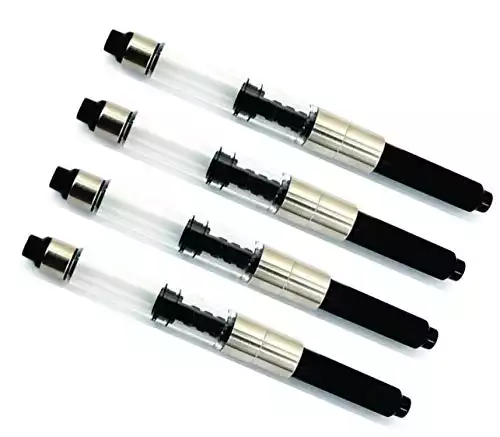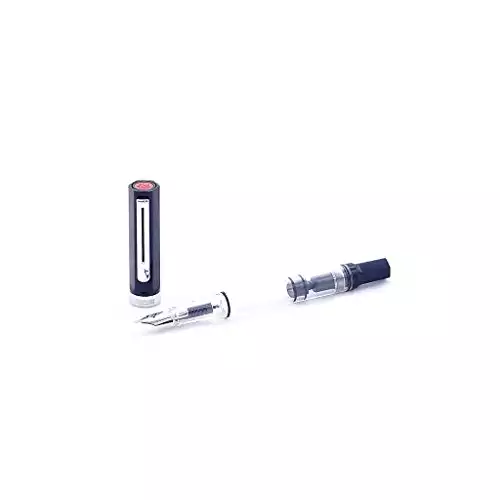Fountain pens are amazing! But they need a little extra care than your normal pens, but that’s part of their charm. When you learn how to fill a fountain pen with ink, it’s like you’re becoming a fountain pen wizard.
In this guide, I’m going to show you the different ways you can fill a fountain pen, share some easy tips to make the process smoother, and even help you fix common problems.
Understanding Fountain Pen Mechanics
Before we get into how to fill your fountain pen with ink, let’s break down how a fountain pen works. A fountain pen consists of a nib, feed, and reservoir.
- The nib is the metal tip that contacts the paper and spreads the ink; the feed regulates the flow of ink to the nib, and the reservoir holds the ink.
- The feed is a small piece of plastic or ebonite that fits snugly against the nib and draws ink from the reservoir.
- The reservoir can be refillable or disposable and comes in different sizes depending on the pen model.
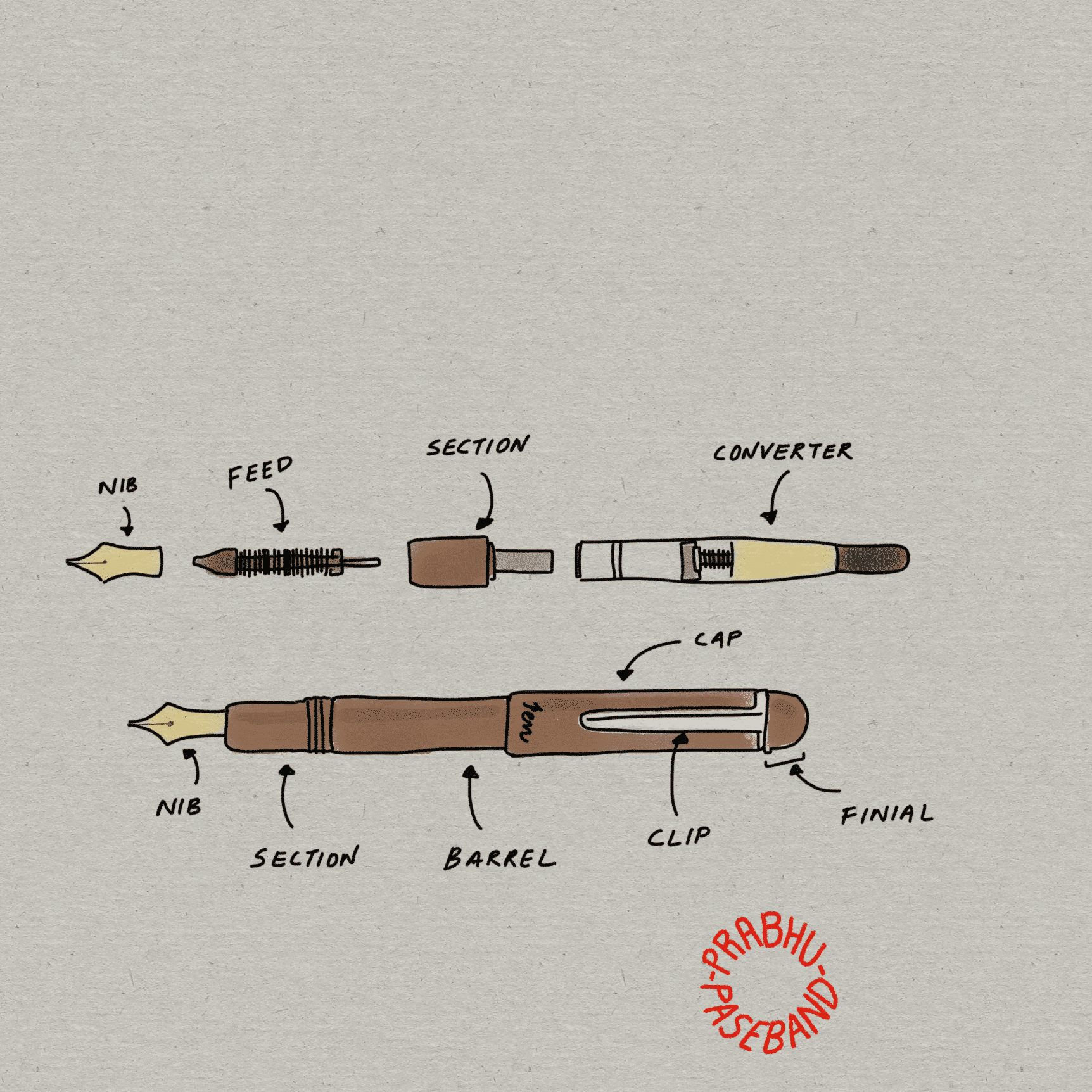
A fountain pen uses a nib to deposit ink onto paper. Unlike ballpoint pens, which use a rolling ball to transfer ink, fountain pens use capillary action to draw ink from a reservoir onto the paper.
Capillary what?
Capillary action allows liquids to flow in narrow spaces, even against gravity. It’s the same process that allows plants to draw water from their roots up into their leaves.
In the context of a fountain pen, capillary action is the mechanism that allows ink to flow from the pen’s reservoir through the feed and onto the paper. When you touch the nib of the pen to the paper, the ink is drawn out by the capillary action between the paper and the pen nib.
In essence, the ink is being “pulled” out of the pen onto the paper. This is why you do not need to apply pressure when writing with a fountain pen, unlike with a ballpoint pen. This capillary action, along with gravity, ensures a smooth and continuous flow of ink for a pleasant writing experience.
Anatomy of a Fountain Pen
The nib, feed, and reservoir are all housed in the pen’s barrel, which can be made of different materials such as plastic, resin, or metal. The barrel is the part of the pen that you hold while writing, and it can be shaped in various ways to fit different hand sizes and writing styles.
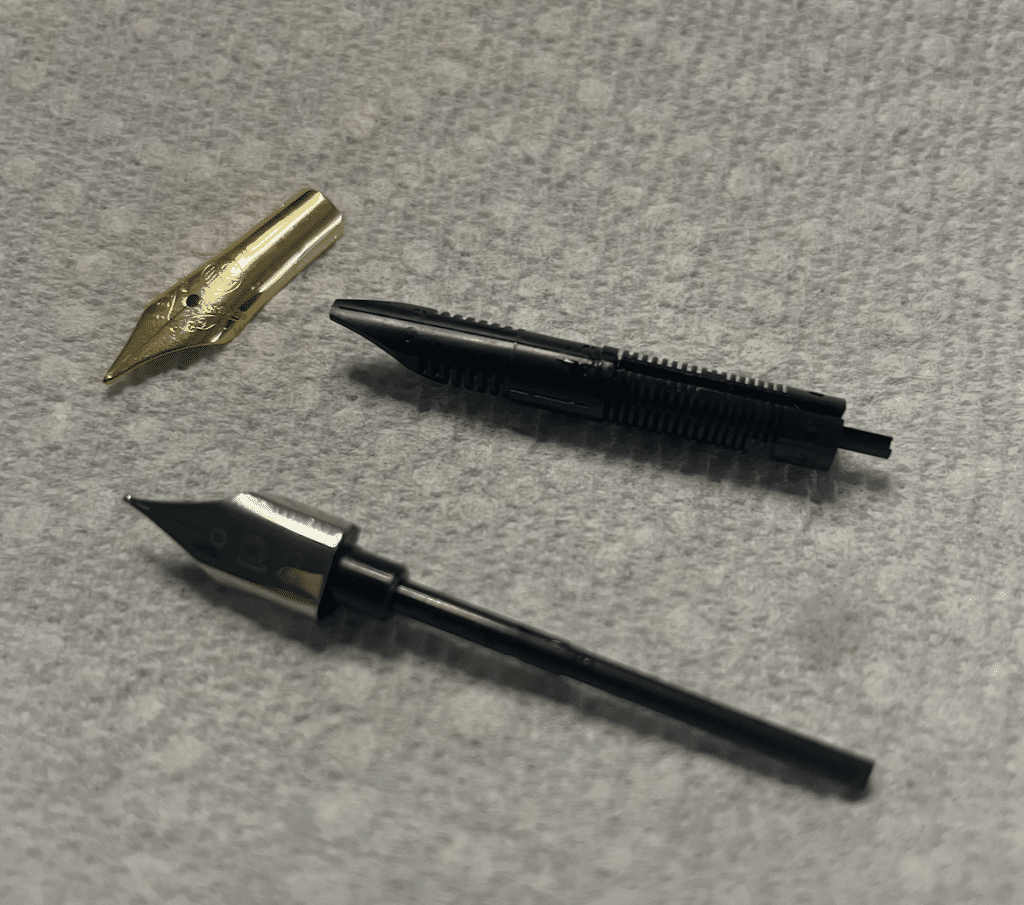
The nib comes in different types and sizes, from fine to broad, and it can be made of steel, gold, or other metals. The size of the nib determines the thickness of the written line, with finer nibs producing thinner lines and broader nibs producing thicker lines.
The feed is designed to regulate the flow of ink to the nib and prevent the nib from becoming flooded with ink. It accomplishes this by controlling the amount of air that enters the reservoir, which affects the rate at which ink is drawn into the nib.
Types of Fountain Pen Filling Systems
There are several types of fountain pen ink filling systems, each with its advantages and disadvantages. Here are the most common ones:
Cartridge/Converter Fountain Pens:
These pens use either disposable ink cartridges or refillable converters that attach to the pen. Cartridge pens are more convenient, as you can easily swap out empty cartridges for new ones. Converter pens are more cost-effective, as you can refill them with bottled ink instead of buying new cartridges. To fill up the pen, you either replace the empty cartridge with a new one or attach the converter, submerge the nib and feed in ink, and twist the mechanism to draw the ink into the converter.
Piston Filler Fountain Pens:
These pens have a piston mechanism that draws ink into the reservoir directly from a bottle. Piston fillers are popular among fountain pen enthusiasts because they can hold a large amount of ink and don’t require frequent refilling. To fill a piston filler pen, you twist the end of the pen to lower the piston, submerge the nib and feed in ink, and twist the end in the opposite direction to raise the piston and suck in the ink.
Vacuum Filler Fountain Pens:
These pens have a unique filling system that uses a vacuum to draw ink into the reservoir. Vacuum fillers are less common than other types of fountain pens. But they are highly sought after by collectors. To fill a vacuum filler pen, you unscrew the end of the pen, pull back the plunger, submerge the nib and feed in ink, and push the plunger back, creating a vacuum that sucks in the ink.
Eyedropper Fountain Pens:
These pens have no mechanism and rely on gravity to feed ink from an eyedropper into the barrel. Eyedropper pens are simple and elegant. But they can be messy and require frequent refilling. And you need to be sure the seal is good; otherwise, the ink will leak and could cause stains. To fill an eyedropper pen, you unscrew the barrel from the nib section, use an eyedropper to fill up the barrel with ink, and screw the barrel back onto the nib section.
Now that your fountain pen is clean and maybe even disassembled, you’re ready to fill it with ink and start writing. Preparing your pen properly can help make sure it writes smoothly and without any problems. Trust me. It’s worth the extra time.
Preparing Your Fountain Pen for Filling
Using a fountain pen is a really special experience. But, to keep it writing smoothly, you need to prepare your pen before filling it with ink. This means cleaning it and maybe even taking it apart, which will help it last longer and write more smoothly.
Cleaning Your Fountain Pen
Before you fill your fountain pen, it’s a good idea to clean it, especially if it’s been a while since you used it last or if you’re changing ink colors. Cleaning your pen helps to get rid of any old ink or gunk that could be hiding in the nib or feed.
Here’s an in-depth guide to getting started with cleaning your fountain pen.
To clean your fountain pen, start by taking it apart if you need to. Then, rinse the nib and feed with warm (not hot!) water until the water runs clear. If your pen is really dirty, you might need to use a special pen cleaning solution. Just be sure to follow the instructions on the bottle, and be careful not to get a ton of water on the barrel or converter. Water could damage these parts.
Taking Apart Your Fountain Pen (Only If You Need To)
If you have a piston or vacuum filler fountain pen, you might need to take it apart to get to the filling mechanism. This might sound scary, but it’s not so bad if you’re careful.
First, check the instructions that came with your pen. Some pens might need a special tool or technique to take them apart.
I love my TWISBI Eco with a medium nib. It's such a smooth writer, and the clear barrel also shows off your ink. It's a great all-around pen.
My TWISBI Eco came with a special wrench, for example. Once you’ve taken your pen apart, be sure to keep track of all the pieces. If you’re unsure, you can take pictures or refer back to the instructions.
Now your fountain pen is clean and maybe even disassembled. So you’re ready to fill it with ink and start writing. Preparing your pen properly can help make sure it writes smoothly and without any problems. Trust us; it’s worth the extra time.
If you have a piston or vacuum filler fountain pen, you may need to disassemble it to access the mechanism. However, it’s important to do this safely and carefully to avoid damaging any delicate parts of the pen.
First, consult the pen manufacturer’s instructions for how to disassemble the pen. Some pens may require a special tool or technique to take apart. Once you have disassembled the pen, take care to keep track of all the pieces and where they go. If you’re unsure, take photos or refer back to the instructions.
Once you have cleaned and disassembled (if necessary) your fountain pen, you’re ready to fill it with ink and start writing. Taking the time to properly prepare your pen can help to ensure that it writes smoothly and without any issues. That makes for a more enjoyable writing experience.
Download this cheatsheet and get expert solutions for the 13 most common pen problems.
Get The FREE CheatsheetFilling Methods for Different Fountain Pen Systems
Now that you’re ready to fill your fountain pen let’s look at the specific methods for each filling system.
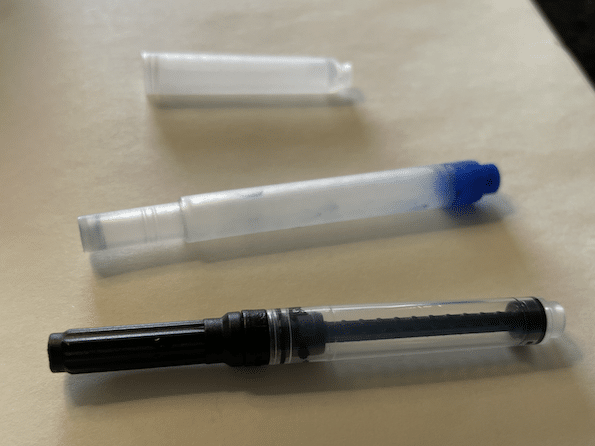
Cartridge/Converter Fountain Pens
To fill up a cartridge/converter fountain pen, you need to do the following:
- Unscrew the barrel from the nib section.
- Take out the empty cartridge or attach the converter.
- Submerge the nib and feed in ink, but don’t go beyond the breather hole (a small hole on the nib that prevents airlocks).
- Twist the converter mechanism to draw the ink into the converter or push the cartridge back into the pen.
- Reassemble the pen and wipe off any excess ink.
Piston Filler Fountain Pens
To fill up a piston filler fountain pen, you need to do the following:
- Twist the end of the pen to lower the piston all the way down.
- Submerge the nib and feed in ink until they’re almost covered.
- Twist the end of the pen in the opposite direction to raise the piston and draw the ink into the reservoir. Repeat several times until the reservoir is full.
- Reassemble the pen and wipe off any excess ink.
Vacuum Filler Fountain Pens
To fill up a vacuum filler fountain pen, you need to do the following:
- Unscrew the end of the pen and pull back the plunger all the way.
- Submerge the nib and feed in ink until they’re almost covered.
- Push the plunger back in slowly, creating a vacuum that draws the ink into the reservoir.
- Reassemble the pen and wipe off any excess ink.
Eyedropper Fountain Pens
To fill up an eyedropper fountain pen, you need to do the following:
- Unscrew the barrel from the nib section and remove any residual ink with a tissue or cotton swab.
- Use an eyedropper to fill up the barrel with ink. But don’t go beyond 80% of the barrel’s capacity to prevent leaks.
- Screw the barrel back onto the nib section, making sure the threads are tight.
- Wipe off any excess ink.
Tips for a Smooth Filling Process
Filling a fountain pen can be messy and frustrating, but with these tips, you can make it a more enjoyable experience.
Picking the Right Ink
Not all ink may work with all pens and nibs. So before you start filling your pen with various inks, make sure you pick the best ink for your fountain pen. If you love shimmer inks, for example, you may need to write with a wider nib and a converter or eye drop pen. Most brands don’t sell shimmer cartridges, and the flecks could get caught in a vacuum or piston system.
Avoiding Ink Spills and Messes
Always handle the pen and the ink bottle with care, and work on a clean surface to avoid stains. Use a syringe or eyedropper to transfer ink into your converter or pen if necessary, and wipe off any excess ink with a tissue. If you accidentally get ink on your fingers or clothes, here’s how to remove it.
Ensuring a Proper Ink Flow
If your pen seems scratchy or doesn’t write smoothly after filling it up, it may be because the feed isn’t saturated with ink yet. Give it a few minutes to soak, or try scribbling on a piece of paper to get the ink flowing. You can also adjust the ink flow by turning the nib’s breather hole slightly left or right.
Troubleshooting Common Filling Issues
Sometimes you might run into problems when you’re filling your pen. Here are some common issues and how to fix them:
Incomplete Ink Filling
If your pen isn’t filling all the way, it might be because of an airlock or blockage in the feed. Try gently tapping the pen against a flat surface or moving the plunger or converter back and forth a few times to create a vacuum. If that doesn’t work, try holding the pen with the nib down for a few seconds or press it against a tissue to help the ink flow.
Leaking or Overflowing Ink
If your pen is leaking or spilling ink, it could be because the nib and feed aren’t aligned right or the pen is too full. Try wiping off any extra ink, adjusting the nib and feed, or using less ink. If the problem keeps happening, your pen might have a crack or damaged part that needs to be fixed.
Air Bubbles and Ink Flow Problems
If you’re getting air bubbles or having trouble with the ink flow, it could be because of a bad seal or a clogged feed. Try taking apart the pen and cleaning the feed with a pen cleaning solution or a toothbrush. Make sure the pen’s design lets air in and out to avoid airlocks.
Now You Know How to Fill a Fountain Pen With Ink
Now that you know how to fill a fountain pen, you can enjoy the beauty of this writing instrument and experiment with different inks and colors. Remember to handle your pen with care, take your time, and don’t be afraid to troubleshoot if you encounter any issues. Happy writing!
Liz
Hey, I'm Liz. I'm the founder of this thing. Pen-obsessed and a notebook nut, I love writing by hand. So I'm gonna talk about it on a computer.Download this cheatsheet and get expert solutions for the 13 most common pen problems.
Get The FREE Cheatsheet
